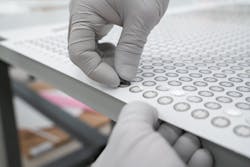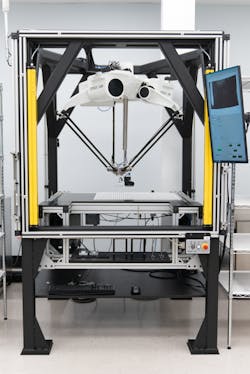As products and their components get smaller, the processes to produce them require manufacturers to find new ways to get the job done. For US Digital, which had to deal with tiny Mylar disks for its new E4T Miniature Optical Kit Encoder, the solution was to integrate a delta robot into the production line to handle the tedious task of picking and placing the disks.
The E4T encoder was designed to meet the growing demand for miniaturized motion control products. At its heart is a transparent Mylar disk with black lines on it. Operators produce the disks on a large sheet, placing the film on a backing sheet of paper. They then transfer it to a laser machine that cuts out individual disks. The heat from the laser slightly melts the edges of the disks so that they adhere to the backing sheet of paper underneath.
For years the next step—called disk picking—was done by hand, with operators removing each disk from the backing sheet. The new, smaller disks for the E4T encoder made this task nearly impossible.
The disks are only half an inch in diameter, roughly the size of a shirt button, but much thinner at seven thousandths of an inch. They were extremely difficult to pick up and stack on a storage rod. The miniature disks meant operators were spending more and more time at the intensely laborious job of disk picking, which limited the time they could spend on more important tasks.
Compounding the problem, each disk has two tabs that protrude into its center. These tabs align with grooves in the hub where the disk is mounted in the assembly process. The operators had to precisely align the tabs with grooves cut into the stacking rod, something they never had to do with other encoder disks. The grooves help prevent damage to the tabs while they are stored in inventory. Aligning the tabs with the grooves made it much harder for the operators to stack the disks.
“Picking and stacking E4T disks by hand didn’t make sense, especially since there are more than 1,000 disks on each sheet,” says Neal Donowitz, chief operating officer at US Digital. “It was a tedious and time-consuming process that was a great candidate for automation. We always look for ways that machines can help our people, rather than having our people help machines.”
Donowitz followed the US Digital core value of vertical integration and chose to do the development in-house using its own engineering expertise and resources. The robot would be a purchased part, but US Digital engineers, machinists, and operators would use their skills to build everything else needed for the job.
Their first task was to choose the best type of robot for the process. After considering a number of options, the team ultimately picked a delta robot. “Delta robots are great because all the heavy parts, like the motors, don’t have to move through space,” explains US Digital CEO and founder David Madore. “They’re rigidly mounted to the top of a frame and only the lightweight arms hang down. Since they can accelerate quickly and move at high speeds, delta robots are ideal for transferring lightweight loads very rapidly.”
The station’s design includes a massive outer frame, made of square steel tubes, which weighs just over 800 pounds. “The frame had to be very rigid,” says project leader Kyle Viestenz, a mechanical engineer at US Digital, “because it has to stabilize all the components during robot operation to assure positioning accuracy.”
Rather than bolting the frame to the concrete floor, as is commonly done, Viestenz used vibration-isolating rubber padding under each foot to damp any structural vibrations of the frame.
A worktable is mounted inside the frame where the sheets of paper with the disks are placed. The sheets are held in place by vacuum channels machined into the worktable. The station also includes a vision system to determine the skew of the sheet so the robot will pick it up from the correct location. A tool attached to the robot’s arm uses vacuum channels and O-ring seals to pick up the disks, and a jet of compressed air discharges the disks onto a vertical stacking rod.
Operators control the machine by selecting options from the station’s human-machine interface, while a light curtain assures safe operation. If someone moves too close, an emergency stop halts the robot immediately.
As the machine began to take shape, much of the development work went as planned. Some tasks, however, required extra work and unexpected problems arose along the way. Motion programming, for example, took some time to get speeds and accelerations just right. A sensor also had to be installed to check vacuum pressure after each disk was picked up.
Not surprisingly, since the machine was designed to pick up small disks for the E4T encoder, some adjustments had to be made when larger disks were required for other products. A series of tools were designed to accommodate the various disk sizes and were machined in-house by US Digital machinists. Viestenz also designed a rack to hold the tools when they’re not in use, fitting it conveniently between the frame and worktable.
The disk picking machine is now at work in the production area, allowing operators to focus their efforts on higher-level tasks in the laser cutting room and darkroom.


